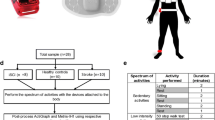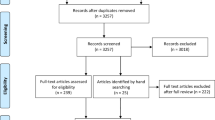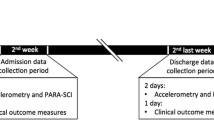Abstract
Purpose of Review
The purpose of this article was to describe the utilization of body-worn activity monitors in the spinal cord injury (SCI) population and discuss the challenges of using body-worn sensors in rehabilitation research.
Recent Findings
Many activity monitor-based measures have been used and validated in the SCI population including stroke number, push frequency, upper limb activity counts, and wheelchair propulsion distance measured from a sensor attached to the wheelchair.
Summary
The ability to accurately measure physical activity in the free-living environment using body-worn sensors has the potential to enhance the understanding of barriers to adequate activity and identify possible effective interventions. As the use of activity monitors used in SCI rehabilitation research continues to grow, care must be taken to overcome challenges related to participant adherence and data quality.
Similar content being viewed by others
References
Papers of particular interest, published recently, have been highlighted as: • Of importance
Matthews CE, Ainsworth BE, Thompson RW, Bassett DR Jr. Sources of variance in daily physical activity levels as measured by an accelerometer. Med Sci Sports Exerc. 2002;34(8):1376–81.
Ward DS, et al. Accelerometer use in physical activity: best practices and research recommendations. Med Sci Sports Exerc. 2005;37(11 Suppl):S582–8.
Masse LC, et al. Accelerometer data reduction: a comparison of four reduction algorithms on select outcome variables. Med Sci Sports Exerc. 2005;37(11 Suppl):S544–54.
Warms CA, Belza BL. Actigraphy as a measure of physical activity for wheelchair users with spinal cord injury. Nurs Res. 2004;53(2):136–43.
Piercy KL, Troiano RP, Ballard RM, Carlson SA, Fulton JE, Galuska DA, et al. The physical activity guidelines for Americans. JAMA. 2018;320(19):2020–8.
Ginis KAM, et al. Correction: Evidence-based scientific exercise guidelines for adults with spinal cord injury: an update and a new guideline. Spinal Cord. 2018;56(11):1114.
Dearwater SR, et al. Assessment of physical activity in inactive populations. Med Sci Sports Exerc. 1985;17(6):651–5.
Brogioli, M., et al., Multi-day recordings of wearable sensors are valid and sensitive measures of function and independence in human spinal cord injury. J Neurotrauma, 2016.
Hiremath SV, Intille SS, Kelleher A, Cooper RA, Ding D. Estimation of energy expenditure for wheelchair users using a physical activity monitoring system. Arch Phys Med Rehabil. 2016;97(7):1146–1153 e1.
Ojeda M, Ding D. Temporal parameters estimation for wheelchair propulsion using wearable sensors. Biomed Res Int. 2014;2014:645284.
Sonenblum SE, Sprigle S, Lopez RA. Manual wheelchair use: bouts of mobility in everyday life. Rehabil Res Pract. 2012;2012:753165.
Sonenblum SE, et al. Validation of an accelerometer-based method to measure the use of manual wheelchairs. Med Eng Phys. 2012;34(6):781–6.
• Tsang K, Hiremath SV, Crytzer TM, Dicianno BE, Ding D. Validity of activity monitors in wheelchair users: a systematic review. J Rehabil Res Dev. 2016;53(6):641–58 This review analyzed the validity of sensors in detecting energy cost, user movement, and wheelchair movement of individuals in a wheelchair and found current methods/algorithms do not estimate energy expenditure for wheelchair users as well as commercial devices do for the able-bodied population.
Bassey E, et al. Validation of a simple mechanical accelerometer (pedometer) for the estimation of walking activity. Eur J Appl Physiol Occup Physiol. 1987;56(3):323–30.
• Routhier F, et al. Clinicians' and researchers' perspectives on manual wheelchair data loggers. Arch Phys Med Rehabil. 2017;98(7):1480–9 Fifty-seven researchers and 17 clinicians ranked “distance traveled” by manual wheelchair users as the most important outcome to understand from data loggers.
Salbach NM, O'Brien K, Brooks D, Irvin E, Martino R, Takhar P, et al. Speed and distance requirements for community ambulation: a systematic review. Arch Phys Med Rehabil. 2014;95(1):117–128 e11.
Bassett JD, Cureton AL, Ainsworth BE. Measurement of daily walking distance-questionnaire versus pedometer. Med Sci Sports Exerc. 2000;32(5):1018–23.
Dobkin BH, et al. Reliability and validity of bilateral ankle accelerometer algorithms for activity recognition and walking speed after stroke. Stroke. 2011;42(8):2246–50.
Crouter SE, et al. Measuring steps, distance, and energy cost. Med Sci Sports Exerc. 2003;35(8):1455–60.
Aminian K, et al. Spatio-temporal parameters of gait measured by an ambulatory system using miniature gyroscopes. J Biomech. 2002;35(5):689–99.
Doheny EP, Foran TG, Greene BR. A single gyroscope method for spatial gait analysis. Conf Proc IEEE Eng Med Biol Soc. 2010;2010:1300–3.
Fortune E, Lugade V, Morrow M, Kaufman K. Validity of using tri-axial accelerometers to measure human movement–part II: step counts at a wide range of gait velocities. Med Eng Phys. 2014;36(6):659–69.
Conwell LS, Trost SG, Spence L, Brown WJ, Batch JA. The feasibility of a home-based moderate-intensity physical activity intervention in obese children and adolescents. Br J Sports Med. 2010;44(4):250–5.
Kenyon A, et al. Validity of pedometers in people with physical disabilities: a systematic review. Arch Phys Med Rehabil. 2013;94(6):1161–70.
Hurd WJ, Morrow MM, Miller EJ, Adams RA, Sperling JW, Kaufman KR. Novel approaches to objectively assess shoulder function. J Shoulder Elb Surg. 2014;23(10):e251–5.
• McCracken LA, et al. Wrist accelerometry for physical activity measurement in individuals with spinal cord injury—a need for individually calibrated cut-points. Arch Phys Med Rehabil. 2018;99(4):684–9 Twenty individuals with spinal cord injuries had varying moderate-to-vigorous physical activity points throughout a variety of activities suggesting the need for individualized cut-points in this population.
Lugade V, et al. Validity of using tri-axial accelerometers to measure human movement - part I: posture and movement detection. Med Eng Phys. 2014;36(2):169–76.
Murphy SL, Kratz AL, Zynda AJ. Measuring physical activity in spinal cord injury using wrist-worn accelerometers. Am J Occup Ther. 2019;73(1):7301205090p1–7301205090p10.
Kooijmans H, et al. Valid detection of self-propelled wheelchair driving with two accelerometers. Physiol Meas. 2014;35(11):2297.
Popp WL, et al. A novel algorithm for detecting active propulsion in wheelchair users following spinal cord injury. Med Eng Phys. 2016;38(3):267–74.
• Albert MV, et al. In-lab versus at-home activity recognition in ambulatory subjects with incomplete spinal cord injury. J Neuroeng Rehabil. 14(1):10 A machine learning model was created to detect lying, sitting, standing, walking, wheeling, and stair climbing in individuals with incomplete spinal cord injuries. Individualized machine learning models could be implemented to detect specific movements for individuals with varying levels of ability.
Maijers M, et al. Is Fitbit Charge 2 a feasible instrument to monitor daily physical activity and handbike training in persons with spinal cord injury? A pilot study. Spinal Cord Ser Cases. 2018;4(1):84.
Adam Noah J, Spierer DK, Gu J, Bronner S. Comparison of steps and energy expenditure assessment in adults of Fitbit Tracker and Ultra to the Actical and indirect calorimetry. J Med Eng Technol. 2013;37(7):456–62.
Takacs J, et al. Validation of the Fitbit One activity monitor device during treadmill walking. J Sci Med Sport. 2014;17(5):496–500.
Kressler J, et al. Accuracy and precision of consumer-level activity monitors for stroke detection during wheelchair propulsion and arm ergometry. PLoS One. 2018;13(2):e0191556.
Jayaraman C, et al. Variables influencing wearable sensor outcome estimates in individuals with stroke and incomplete spinal cord injury: a pilot investigation validating two research grade sensors. J Neuroeng Rehabil. 2018;15(1):19.
Glasheen E, Domingo A, Moreno D, Kressler J. Validity of Apple Watch fitness tracker for wheelchair users. Arch Phys Med Rehabil. 2017;98(12):e178.
Gill ML, et al. Neuromodulation of lumbosacral spinal networks enables independent stepping after complete paraplegia. Nat Med. 2018;24(11):1677–82.
Funding
This publication was made possible by funding from the National Institutes of Health (R01 HD84423-01).
Author information
Authors and Affiliations
Corresponding author
Ethics declarations
Conflict of Interest
The authors declare that they have no conflict of interest.
Human and Animal Rights and Informed Consent
This article does not contain any studies with human or animal subjects performed by any of the authors.
Additional information
Publisher’s Note
Springer Nature remains neutral with regard to jurisdictional claims in published maps and institutional affiliations.
This article is part of the Topical Collection on Spinal Cord Injury Rehabilitation
Rights and permissions
About this article
Cite this article
Goodwin, B.M., Fortune, E., Van Straaten, M.G. et al. Outcome Measures of Free-Living Activity in Spinal Cord Injury Rehabilitation. Curr Phys Med Rehabil Rep 7, 284–289 (2019). https://doi.org/10.1007/s40141-019-00228-5
Published:
Issue Date:
DOI: https://doi.org/10.1007/s40141-019-00228-5




